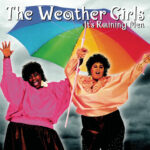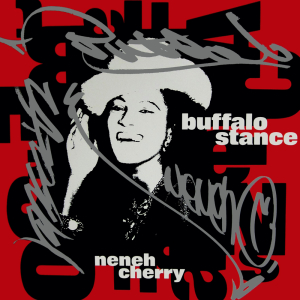 Some songs seem to fall from the sky fully formed, destined to soundtrack celebrations, parades, and pure moments of joy. “It’s Raining Men” by The Weather Girls is one of those songs—a glittering, thunderous disco-pop storm that has endured far beyond its early 1980s origins. Released in 1982, the track became a campy, exuberant anthem that transcended boundaries of gender, sexuality, and genre. It is as much a staple of dance floors as it is a cultural touchstone, woven into the DNA of pop culture.
Some songs seem to fall from the sky fully formed, destined to soundtrack celebrations, parades, and pure moments of joy. “It’s Raining Men” by The Weather Girls is one of those songs—a glittering, thunderous disco-pop storm that has endured far beyond its early 1980s origins. Released in 1982, the track became a campy, exuberant anthem that transcended boundaries of gender, sexuality, and genre. It is as much a staple of dance floors as it is a cultural touchstone, woven into the DNA of pop culture.
For a track that almost never got recorded, its impact is staggering. At once a party starter, a queer anthem, and a lasting emblem of unapologetic fun, “It’s Raining Men” has enjoyed a legacy as enduring as any disco-era classic. It’s the rare song that can be simultaneously kitschy and powerful, funny and iconic, over-the-top yet completely sincere. To understand its place in music history, one must look not only at the story of The Weather Girls, but also at the climate of the early 1980s and the audacious vision of its creators.
The Backdrop: Post-Disco America
By the early ’80s, disco had become a dirty word in many corners of America. The infamous “Disco Demolition Night” of 1979 had symbolized a backlash that was as much about social politics—race, gender, and sexuality—as it was about music. Record companies, fearful of the stigma attached to disco, pivoted hard toward new wave, rock, and R&B, while dance-pop went somewhat underground.
But disco’s spirit didn’t die. It evolved, survived, and came roaring back in more flamboyant and camp-infused forms. On the East Coast, club culture was thriving, and producers still sought larger-than-life voices that could fill dance floors. Into this world stepped two powerhouse singers: Martha Wash and Izora Armstead.
Both women had worked as backup singers for Sylvester, the openly gay disco star who embodied the flamboyance and liberation of the era. Wash and Armstead’s voices were enormous—church-trained, full of gospel power, and built for commanding attention. It was inevitable that they’d eventually step out of the background and into the spotlight.
The Song’s Creation
“It’s Raining Men” wasn’t just a random disco holdover—it was carefully crafted by two legendary songwriters: Paul Jabara and Paul Shaffer. Jabara, who had co-written “Last Dance” for Donna Summer, envisioned the track as another grandiose, tongue-in-cheek celebration of disco excess. Shaffer, best known as David Letterman’s bandleader, contributed his knack for musical bombast and theatrical flair.
The song’s premise was as outrageous as its title: an ecstatic celebration of a world where men quite literally fall from the heavens, each one more irresistible than the last. Its playful absurdity was balanced by an arrangement that gave Wash and Armstead’s voices room to absolutely soar. From the opening thunderclaps to the choral shouts of “Hallelujah!,” everything about it was designed to be larger than life.
Here’s the irony: before The Weather Girls recorded it, the song had been rejected by some of the era’s biggest divas. Donna Summer, Diana Ross, Cher, and even Barbra Streisand all passed on the track, dismissing it as too gimmicky or too camp. What those singers overlooked was exactly what made the song special: it wasn’t afraid to be outrageous. Wash and Armstead leaned into that energy, and in doing so, made the song iconic.
Release and Initial Reception
Released in 1982 on Columbia Records, “It’s Raining Men” was an immediate hit in clubs. DJs latched onto its irresistible beat and thunderous vocals, spinning it heavily in New York, San Francisco, and other nightlife hubs. On the Billboard Hot 100, the song peaked at No. 46—modest by chart standards—but its real impact was on the dance charts, where it hit No. 1.
In the UK, where camp and disco were less stigmatized at the time, the song fared even better, reaching No. 2 on the singles chart. British audiences embraced its flamboyance wholeheartedly, setting the stage for its future as a global dance anthem.
Critics initially treated the track as a novelty, but it quickly became clear that it was much more than a throwaway. With each booming chorus, Martha Wash and Izora Armstead transformed it from camp joke to powerhouse declaration. Few songs could be so tongue-in-cheek yet delivered with such conviction.
A Queer Anthem Is Born
Almost immediately, “It’s Raining Men” found its truest home within LGBTQ+ communities. The song’s unabashed camp, combined with its message of abundance, fantasy, and freedom, made it an instant hit in gay clubs. Wash and Armstead, both steeped in gospel traditions, brought a sense of celebratory ecstasy that resonated deeply with audiences searching for joy and affirmation in the face of marginalization.
By the mid-1980s, “It’s Raining Men” was firmly entrenched as a queer anthem. It blared from parade floats at Pride celebrations, became a drag performance staple, and served as a soundtrack for countless nights of collective release on the dance floor. Its embrace of fantasy—where men fall from the sky like blessings—was a gleeful rejection of shame and restraint.
The Power of the Vocals
What makes the song endure isn’t just its camp premise—it’s the staggering vocal performance. Martha Wash’s booming delivery practically lifts the track off the ground, while Izora Armstead’s harmonies and counterlines add richness and drama. Their voices transform playful lyrics into something truly thunderous.
The Weather Girls didn’t approach the track as a gimmick. They sang it with the same power they might bring to a gospel hymn, turning lyrics about raining men into something divine. This combination—camp subject matter delivered with absolute sincerity—became the secret to the song’s longevity.
Pop Culture Immortality
Over the decades, “It’s Raining Men” has been featured in countless films, TV shows, and commercials. It became a standout moment in Bridget Jones’s Diary (2001), scored comedy sketches, and was performed by drag queens on countless stages worldwide. Its mere opening notes are enough to provoke recognition and excitement.
In 2001, former Spice Girl Geri Halliwell covered the track for the Bridget Jones’s Diary soundtrack, introducing it to a new generation. While her version charted higher globally, the Weather Girls’ original remains definitive—its thunderclaps and powerhouse vocals simply unmatched.
Even today, the song is a go-to for karaoke nights, wedding receptions, and drag performances. It is a track that has transcended its era, woven permanently into the cultural fabric.
Beyond the Song: The Weather Girls’ Legacy
Though best remembered for “It’s Raining Men,” The Weather Girls were far from a one-hit act in terms of artistry. Both Wash and Armstead had long careers as session singers, lending their voices to numerous hits. Martha Wash, in particular, went on to achieve legendary status in the dance music world, providing vocals for hits by Black Box (“Everybody Everybody”) and C+C Music Factory (“Gonna Make You Sweat (Everybody Dance Now)”)—though she often battled for proper credit.
Their story is also emblematic of how Black women’s voices have often powered the dance and pop world without always receiving due recognition. “It’s Raining Men” gave them a moment in the spotlight that history could never erase.
Why It Endures
So why does a song from 1982 still electrify dance floors in 2025? The answer lies in its perfect fusion of joy, camp, and catharsis. It’s not a song that asks to be taken seriously; it demands to be celebrated. Its over-the-top premise gives listeners permission to let go of inhibitions, while its gospel-sized vocals elevate the entire experience into something transcendent.
It also carries a message that has aged well: abundance, liberation, and unapologetic fun. In a world often weighed down by seriousness, “It’s Raining Men” is a reminder that sometimes the most radical act is to dance and celebrate without restraint.
Conclusion: A Storm That Never Ends
“It’s Raining Men” isn’t just a disco song, a camp joke, or a dance floor staple—it’s all of those things at once, and more. It’s a piece of pop culture that has weathered changing tastes and eras, proving that joy, when delivered with conviction, never goes out of style.
For The Weather Girls, it was a moment of lightning in a bottle. For audiences, it became a gift that continues to fall from the sky, again and again, every time those thunderclaps signal that the storm of joy is about to begin.
In the end, the song’s genius lies in its refusal to choose between sincerity and parody. It is both, simultaneously—a glorious thunderstorm of camp and power that remains as irresistible today as it was in 1982. And as long as people crave songs that make them laugh, sing, and dance in equal measure, it will keep raining men for generations to come.


